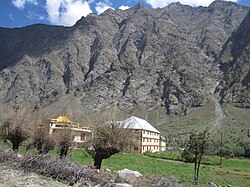Jispa
In this article, we will explore everything related to Jispa, from its historical origin to its impact on today's society. Jispa has been a passionate and controversial topic over the years, generating debate and interest in different areas. Through a comprehensive and detailed analysis, we will delve into the complexity of Jispa, examining its various facets and perspectives. From its origins to its contemporary evolution, this article offers a comprehensive view of Jispa and its relevance in today's world.
Jispa | |
|---|---|
village | |
 | |
| Coordinates: 32°38′0″N 77°10′0″E / 32.63333°N 77.16667°E | |
| Country | |
| State | Himachal Pradesh |
| District | Lahaul and Spiti |
| Area | |
• Total | 0.49 km2 (0.19 sq mi) |
| Elevation | 3,200 m (10,500 ft) |
| Population (2011) | |
• Total | 202 |
| • Density | 410/km2 (1,100/sq mi) |
| Languages | |
| • Official | Hindi |
| Time zone | UTC+5:30 (IST) |
| Vehicle registration | HP |
| Website | https://hplahaulspiti.nic.in/ |



Jispa (elevation 3,200 m or 10,500 ft; population 202)[1]: 81–82 is a village in Lahaul, in the Indian state of Himachal Pradesh.
Geography
Jispa is located 22 km (14 mi) north of Keylong[2][3] and 7 km (4.3 mi) south of Darcha,[4] along the Manali-Leh Highway and the Bhaga river.[3] There are approximately 20 villages between Jispa and Keylong.[5]
Demographics
According to the 2011 census, of the town's 202 residents, 113 were male and 89 were female. One belonged to scheduled castes, and 177 belonged to scheduled tribes. The village had 51 households.[1]

Amenities
The village has a helipad, a post office,[6] and a monastery.[7] Travellers often stop for the night here; the village has a hotel, a mountaineers' hut, and a campground.[2][3][4] Jispa also has a small folk museum.[2]
References
- ^ a b District Census Handbook: Lahul & Spiti, Himachal -- Village and Town Wise Primary Census Abstract (PCA). 3 Part XII B. Directorate of Census Operations, Himachal Pradesh, Ministry of Home Affairs, Govt of India. 2011.
- ^ a b c Joe Bindloss & Sarina Singh. India. Lonely Planet (2007), p. 341. ISBN 978-1-74104-308-2.
- ^ a b c "Jispa" Archived 20 August 2010 at the Wayback Machine. Himachal Tourism (2009). Accessed 22 October 2009.
- ^ a b David Abram. Rough Guide to India. Rough Guides (2003), p. 523. ISBN 978-1-84353-089-3.
- ^ Sudha Mahalingam. "On the trail of two rivers". Frontline (18–31 December 2004).
- ^ S.C. Bajpai. Lahaul-Spiti: A Forbidden Land in the Himalayas. Indus Publishing (2002), p. 131. ISBN 978-81-7387-113-9.
- ^ Sandeep Silas. Discover India by Rail. Sterling Publishers (2005), p. 187. ISBN 978-81-207-2939-1.

